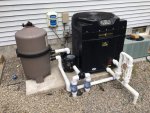I'm replacing my sand filter with a cartridge filter and have a couple of operating questions not covered in the manual (yes I read the manual).
Air bleed - I understand on first start up and after cleaning I need to open the air bleed to let air out and until water comes out. In reviewing some videos discussing cleaning the filters when needed, they mention opening the air bleed before disassembling the tank - and they demonstrate air escaping. Does air build up in the tank over a period of normal use? Do I need to occasionally bleed off air on a regular basis?
First use - any benefit to filling the tank part way with water prior to final re-assembly?
Band tightness - the manual for my model says to tight the tank band to 150 inch pounds which I will do. It also includes all kinds of warnings about this being double checked and secure before starting the pump. And warnings to stay 10 feet away from filter at startup, etc. Watching the videos out there, a guy with a crescent wrench tightens the band 'until the spring is compressed' and fires it up while looking closely for band leaks. I plan to follow the manufacturers directions and warnings, but was interested in whether these are strict safety warnings vs. practical time savings steps vs. darn fools on youtube?
Appreciate any feedback.
Thanks
Air bleed - I understand on first start up and after cleaning I need to open the air bleed to let air out and until water comes out. In reviewing some videos discussing cleaning the filters when needed, they mention opening the air bleed before disassembling the tank - and they demonstrate air escaping. Does air build up in the tank over a period of normal use? Do I need to occasionally bleed off air on a regular basis?
First use - any benefit to filling the tank part way with water prior to final re-assembly?
Band tightness - the manual for my model says to tight the tank band to 150 inch pounds which I will do. It also includes all kinds of warnings about this being double checked and secure before starting the pump. And warnings to stay 10 feet away from filter at startup, etc. Watching the videos out there, a guy with a crescent wrench tightens the band 'until the spring is compressed' and fires it up while looking closely for band leaks. I plan to follow the manufacturers directions and warnings, but was interested in whether these are strict safety warnings vs. practical time savings steps vs. darn fools on youtube?
Appreciate any feedback.
Thanks


